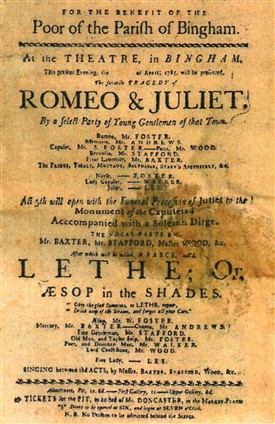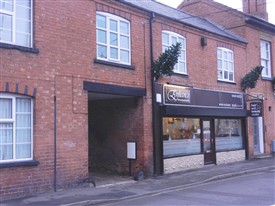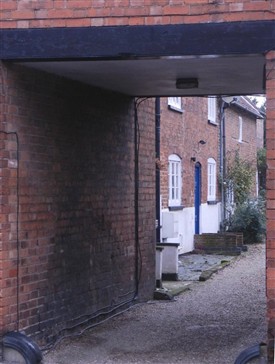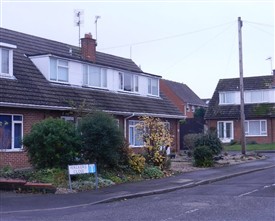The Theatre in Bingham

A playbill for the Bingham theatre, dated 1795

Church Street, showing the archway between Nos.11 and 15. Possible entrance to the first Bingham Theatre

View through the archway between Nos.11 and 15 Church Street showing the yard and 18th century cottages beyond. A possible location for Bingham's first theatre.

Walkers Close today - site of 'Walker's Barn'
"In the year 1785 there was down Church Street an old ramshackle building of two storeys, with thatched roof. On the ground floor was a small two-roomed tenement, with a shop. The upper floor was more of a loft or barn, quite open to the roof - no ceiling - and had one or two small windows looking into Church Street (1).
"It contained a small raised gallery at one end, but the room would not hold more than about fifty people. The stage was at the other end, and was curtained off by two of the old-fashioned patchwork bedquilts, formerly so dear to the heart of the thrifty and industrious housewife. At the side of the stage a small space was also screened for the use of the actors.
"To get to the theatre you had to go under an archway down a cobblestone yard then up an unprotected step-ladder leading to the public entrance door of the building. There you paid your money or showed your ticket and passed into a small room dimly lighted with a few oil lamps....."
The archway referred to in the above paragraph (it has been suggested (2)) is the one between today's Nos.11 and 15 Church Street (see photos), which gives access to a yard of 18th century cottages. It is further suggested that within this yard No.13 Church Street, with its possibility of an upstairs roof space, formerly accessed by a set of outside steps, may be the most likely site for this theatre (2).
Expansion and a new home
The Church Street theatre is thought to have been operational from 1783 to 1785, by which time the premises had become too small. New premises were sought, and the theatre moved to a site on Long Acre known as Walker's Barn (3), opposite what is today the Horse & Plough pub.
This building, in which it is said two galleries were constructed, no longer survives, the site now being occupied by the housing of Walkers Close (see photo)
Some of the plays performed at the Bingham Theatre were
"Romeo & Juliet" (See illustration)
"Tunbridge Walks, or the Yeoman of Kent"
"The Flitch of Bacon"
"The fair Penitent"
"The Mock Doctor, or the Dumb Lady Cur'd"
As a result of these Bingham Theatre plays a sum of £80 was raised towards a fund for a school. Mr George Baxter and Mr John Foster added £70, and the whole (£150) was invested in shares in the Nottingham and Grantham Canal, worth in 1832 about £10 a year. Since that time alterations were subsequently made whereby, by the early years of the 20th century, the interest was being spent in assisting a few old people living in Bingham and neighbouring parishes (1).
Notes
(1) This account of the theatre at Bingham is quoted mainly from an item by Edward Stone of Radcliffe-on-Trent, published in 'Notes and Queries' No.181 in The Nottinghamshire Guardian, 16th December 1916
(2) website of the Bingham Heritage Trails association (BHTA), accessed December 2016. http://www.binghamheritage.org.uk/index.php
(3) WORTLEY, Adelaide A. History of Bingham (1954)